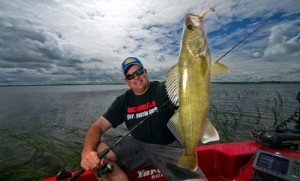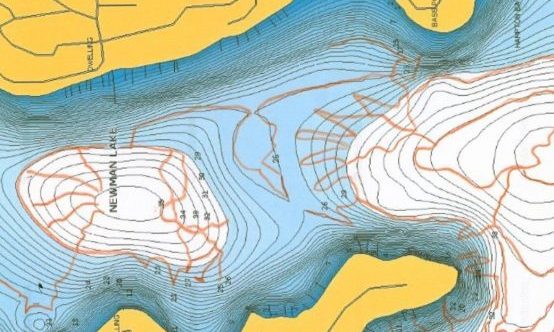Fast forward to fall walleye fishing and the worst thing that can happen to most patterns is the opposite, a hot stretch of unseasonably warm weather that warms up the water temperature and reverses the cool down.
by Jason Mitchell
Cooling water temperatures often make the classic fall walleye fishing bites better. As water temperatures steadily cool come fall and sink below seventy degrees, solid patterns seem to develop. My favorite patterns are classic breaks and hard bottoms over deeper off shore structure, along with current or bottlenecks and shallow rock and weeds. What is kind of interesting regarding fall fishing is that the triggers that make the bite good are the exact opposite of spring.
During the spring, warming water temperatures and stable weather seem to ignite the fall walleye fishing bite. When water temperatures steadily rise, the fishing gets easy, good and predictable. When the water temperature crashes even a few degrees because of a front, the bite typically becomes tougher, unpredictable and changing. A thirty mile per hour wind and cold front that drops the water temperature six degrees over a twenty four hour time period is the worst thing that can happen to you in May on most natural lakes and reservoirs.
Fast forward to fall walleye fishing and the worst thing that can happen to most patterns is the opposite, a hot stretch of unseasonably warm weather that warms up the water temperature and reverses the cool down. When the nights start getting cool and the water temps start dropping, the fish start chomping but watch that pattern change when the cool down comes to a temporary halt.
Where you are in relation to water temps should play a key role in your strategy for finding and catching walleyes when fall walleye fishing. As a general rule of thumb, I find fish scattered and more unpredictable when the water temperature spikes upward in the fall.
When temperatures slowly drop, the fish seem to concentrate and become more predictable. Often however, the bite will get better during the fall in the afternoon when the water temperature warms slightly through the day just like in the spring but what you are looking for during the fall cool down is colder water temperatures in the morning from cooler nights that keep that water temperature dropping despite the sun during the day. If the nights are not cool enough to chill the water enough to keep that temperature down, patterns can unravel quickly.
We can’t control the weather so all we can do is adjust our strategies and mindset so that we can hopefully make good decisions and catch fish. When fish are scattered and patterns seem to be in disarray, you can still catch fish. Sometimes in when fall walleye fishing, it seems like the pattern is that there is no pattern. You will find fish scattered and nothing emerges as a sure deal. When this happens, cover water and fish as many good spots as possible. Know going in to the day that you are probably not going to find a spot that has so many fish where you catch several fish off of one spot.
After you catch the fish or two that lives on a particular spot, keep moving but keep the spot in mind for your milk run. A milk run is exactly what you need when fishing gets tough. Fish as many good spots as possible and keep moving. Over the course of the day, the fish add up.
If I had to pick just one presentation for this scenario, I would break out the lead core and troll crank baits. The reason I like lead core so much for this situation is because of the variation in depth control for finding scattered fish. I can slide up shallower and drop down deeper and make fast adjustments to my running depth while covering a lot of water. I also like to puller bigger baits for fall walleye fishing.
Wide wobbling baits that have a bigger profile and move water are often the key. My favorite crank for this time is the Salmo Bullhead 8SDR but some other good cranks that I have also caught a lot of fish with include the Reef Runner Deep Ripper and the Bomber Long A. Another lure I have fallen in love with over the past couple years that is kind of hard to find but a real walleye killer for me is the Salmo 8SDR Perch, that particular lure catches fish.

Lead core and crank baits will accumulate fish when the going gets tough but when things get good and easy, focus on sitting on top of concentrations of fish. Trolling can still be an important part of the game plan but instead of covering water, the focus changes to pulling cranks back and forth over the same zone until your GPS gets hard to read.
When fish do get piled up on specific spots, different presentations also come into play. Namely presentations that make you more efficient. If fish are tucked along a specific break or structure, sitting over the spot and fishing vertically is tough beat. For fall walleye fishing vertically jigging is obviously productive but for big fish, I don’t know if there is anything more effective than rigging big red tail chubs.
We filmed a segment with guide, Toby Kvalevog of Leisure Outdoor Adventures on Leech Lake last fall and something that Toby said made a lot of sense and stuck with me. Toby stressed that when rigging with big chubs, it is important to fish extremely slow and let the chub do the work.
Video detailing presentation:
That big chub struggling in front of a fish is hard to resist. Obviously, in order for these types of presentations to be real effective, you have to have fish dialed on to the spot and the fish have to be concentrated or sitting on a spot is bad use of time for fall walleye fishing.

Besides classic sharp breaking main lake structure and deep rocks where rigging and jigging can really shine, another great overlooked bet when temps do cool down is shallow weeds and rocks. Bull rushes for fall walleye fishing can get really good again in the fall and cabbage and coon tail can both hold fish. Particularly a top location in weeds in the fall are subtle dish bowls or troughs where slightly deeper water forms open pockets in weeds. These locations load up with fish as well in the fall when water temperatures start dropping.
By monitoring the environment where fish are living and making good decisions, you can capitalize on great fall fishing but remember that the date on the calendar means nothing. For fall walleye fishing everything revolves around cool nights and cold mornings.
Editor’s Note: The author Jason Mitchell hosts the outdoor program Jason Mitchell Outdoors which airs on Fox Sports North and Fox Sports Midwest. More information on Jason Mitchell Outdoors can be found online at www.jasonmitchelloutdoors.com.

